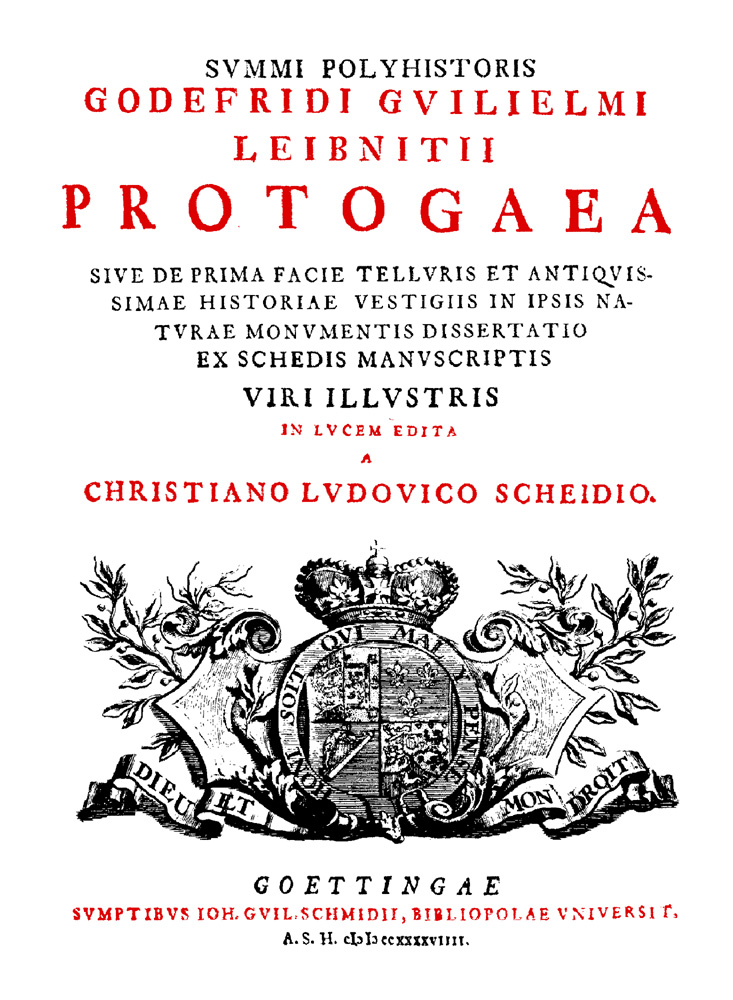LEIBNITZ, Gottfried Wilhelm.
(1646 – 1716)
German philosopher, mathematician, historian and jurist, contemporary of Newton (1642-1727), who left behind no philosophical magnum opus, but who is still considered to be among the giant thinkers of the 17th-century. Leibniz believed in "pre-established harmony" between matter and mind, and developed a philosophy of Rationalism by which he attempted to reconcile the existence of matter with the existence of God. Bertrand Russel wrote that Leibniz's intellect "was highly abstract and logical; his greatest claim to fame is as an inventor of the infinitesimal calculus."Gottfried Wilhelm Leibniz was born in Leipzig as the son of a professor of moral philosophy. He received his masters degree from the University of Leipzig at the age of 18 and his doctorate in law at Altdorf in 1667. Leibniz preferred a courtly to and academich career and in 1669 he entered into the service of the elector of Mainz. Some years later he traveled to Paris to try to persuade Louis XIV to expel the Turks from Egypt in order to distract his attention from marching on Holland. The ploy did not work.In 1675 Leibniz made his most important scientific discovery, the differential and integral calculus which became the basis for modern mathematic. The discovery resulted in a controversy with Isaac Newton over whether he or Newton was the inventor. Nowadays it is generally agreed that they both discovered the basic foundations of the calculus independently, Newton first, but Leibniz's publication prededed that of Newton. Leibniz's system of notation is superior to that of Newton, and is still in use today. Newton's absolute space also was something Leibniz could not accept: "I hold space to be something merely relative, as time is; . . . For space denotes, in terms of possibility, an order to things which exist at the same time, considered as existing together."
Biographical references: DBA: I 360,11; 750,332-404; II 798, 336-461; 799, 1-69. • DSB: 8, ??. • Encyclopaedia Britannica, 11th edition: 16, 385-90. • Gerber, Historisch-biographisches Lexikon, 1812-4. • Hirsch, Biographisches Lexikon, 1884-8. • Hirsching, Historisch-literarisches Handbuch, 1794-1815. • Jöcher, Gelehrten-Lexikon, 1750-51. • NDB. • Poggendorff: 1, cols. 1413-5. • Schaedler, Biographisch Handwörterbuch, 1891: 68. • WBI. • Zischka, Allgemeines Gelehrten-Lexikon, 1961: 376-7.

1. Latin, 1749 [First edition].
[In black:] Svmmi Polyhistoris | [in red:] Godefridi Gvilielmi | Leibnitii | Protogaea | [in black:] Sive De Prima Facie Tellvris Et Antiqvis- | simae Historiae Vestigiis In Ipsis Na- | tvrae Monvmentis Dissertatio | Ex Schedis Manvscriptis | Viri Illvstris | [in red:] In Lvcem Edita | A | Christiano Lvdovico Scheidio. | [in black, ornament] | Goettingae | [in red:] Svmptibvs Ioh. Vil. Schmidii Bibliopolae Vniversit | [in black:] A.S.H. cI[Backwards C] I[Backwards C]ccxxxxviiii.
4°: π2 a-c4 d2 A-L4 (L4 blank); 58l.; [2], XXVI, [2], 86, [2] p., 12 large engraved plates, one engraved title vignette (Brunswick-Luneburg arms) and one engraved textvignette. Title page printed in red and black. Page size: 256 x 184 mm.
Contents: [2 pgs], Title page, verso blank.; [2 pgs], Dedication, signed Christ. Lvdov. Scheidvs.; [i]-xxvi, "Q.D.B.V. | Lectori Honoratissimo | S.P.D. | Christ. Lvd. Scheidivs."; [2 pgs], "Conspectvs Totivs Operis."; [1]-86, Text.; [2 pgs], Blank.; [At end], 12 folding plates.
Plates: The plates are signed N. Seelærider sc. and consist of the following subjects: I. Minerals and fossils, cave cross-section. II. Fossil fish. III-V. Fossil shells. VI. Fossil teeth. VII. Reproduction of Steno's shark's head and teeth plate. VIII. Fossils. IX. Fossil shells. X. Fossils. XI. Fossil skull and fossil teeth. XII. Mastadon tooth and fossil skeleton.
Rare. A great geological classic, which was published by this important mathematician and physiologist, who accepted in his "Protogaea" the Cartesian view, that primitive matter has a fluid consistency owing to the tremendous initial heat and that the earth's spherical form was derived from the aggregation of whirling ultimate elements or "monads" of matter. In place of the Cartesian principle of momentum, Leibnitz starts from a dynamical basis and assumes a force which accomplished the separation of light from darkness or as he also expressed it the separation of the more "active" elements of the universe from the more "passive." (Zittel) The part dealing with mineralogy is much more practical as he became acquainted with the mines of the Harz in Germany and he gives account of the mode of occurences of metals, minerals and fossils in Hannover and Brunswick.
The first description during his lifetime (1646-1716) was published in only 3 pages in the Acta Eruditorum in 1693 without the plates, and this paper remained in a manuscript until it was posthumously published in 1749. However the modern translation into German was published in 1949 by Von Engelhardt.
Bibliographical references: Freilich Sale Catalog: no. 343. • Hoover Collection: no. 521. • LKG: XVII 30 & 31. • Nissen (ZBI): no. 2428. • Norman Catalog: 1, ??, no. 1328. • Ward & Carozzi, Geology Emerging, 1984: no. 1358. • Wellcome Catalog (Books): 3, 482. • Zittel, History of Geology, 1901: p. 27-8.

2. German, 1749 [German transl.].
Gottfried Wilhelm | Leibnitzens | Protogaea | Oder | Abhandlung | Von der ersten Gestalt der Erde | und den Spuren der Historie in den | Denkmaalen der Natur | Aus seinen Papieren herausgegeben | Von | Christian Ludwig Scheid | Aus dem lateinschen ins teutsche | übersetzt. | [double rule] | Leipzig und Hof, | bey Johann Gottlieb Vierling, | privilegirten Buchhändler 1749.
4°: 124 p.
Very rare. "Vorbericht des Uebersetzers" signed: M.W.L.G. The translation was edited by Christian Ludwig Scheid.
Bibliographical references: BL. • NUC.
.